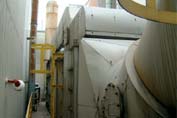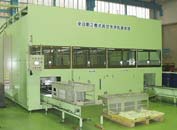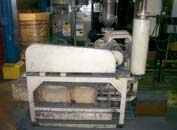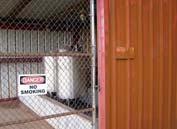Home > About Us > Corporate Social Responsibility > Sustainability Report > Sustainability Report 2006 > Environmentally Friendly Manufacturing (3) Reducing Hazardous Substances
| Environmental Management Sustainability Report 2006 |
|||
| Environmentally Friendly Manufacturing (3) Reducing Hazardous Substances |
Chemical substances that are used in our lives can damage the ozone layer, human health and the ecosystem unless appropriately controlled. Kobe Steel shall continue to properly maintain its environmental facilities; thoroughly control chemical use or reduce the use of chemical substances; and switch to safer alternative substances. |
| Uncompromising Control Toward Reduction |
Kobe Steel set up the Company-wide Chemical Substance Control Policy and strives for thorough control of chemical substances. For example, we use the Control Sheet for Designated Chemical Substances in all the offices throughout the company. With this Sheet, usage and management methods are defined for each chemical substance, and the transferred amount and released amount reported in accordance with the PRTR Law can be calculated accurately. The Control Sheet also enables that the content required to be reported under the PRTR Law is abided, and is used for controlling the amount of consumption and emissions of the substances. Group companies are being urged to adopt this Sheet for chemical substance control. In the total values reported in fiscal 2005 in compliance with the PRTR Law, Kobe Steel handled 33 substances, released 255 metric tons, and transferred 178 metric tons in total. As for group companies, 31 substances were handled, 702 metric tons were released, and 691 metric tons were transferred. *PRTR Law: Pollutant Release and Transfer Register Law (Law concerning Reporting, etc. of Releases to the Environment of Specific Chemical Substances and Promoting Improvements in their Management) |
| Examples of Reduction Efforts |
| To reduce the quantities of chemical substances in use, it is most effective to develop products that do not incorporate those substances or production processes that do not require them. The Moka Plant of the Aluminum and Copper Company, which manufactures aluminum sheet for can stock, is working to reduce output of hazardous substances. It removes 99.5% of the volatile organic solvent (VOC) released from ovens used in the painting process through combustion in incinerators. At the Takasago Works of the Machinery and Engineering Company, new cleaning equipment installed in October 2005 completely eliminates the use of methyl chloride, which was previously used as a liquid cleaning agent, and completes the switch to paraffinic hydrocarbon. At the Chiba Plant of Sun Aluminium Industries, Ltd., the use of formalin in the color coating of aluminum was eliminated. Formalin is a solution of formaldehyde and is used as a disinfectant and preservative. It was a component of the paint that Sun Aluminium was using for its service coating of colored aluminum. In its attempts to make its color-coated aluminum completely free of formaldehyde, the Chiba Plant carried out tests on formaldehyde-free coating and conducted strength tests of the aluminum sheet with regular customers. It was successful in completely eliminating the use of formaldehyde. Under the Air Pollution Control Law, formaldehyde is listed as a hazardous agent of atmospheric pollution requiring priority measures, and companies are making voluntary efforts to reduce emissions. |
 incinerators  Fully automatic 2-tank vacuum cleaning and drying equipment |
| PCB control |
Kobe Steel properly stores transformers, capacitors, and other components that contain PCB (polychlorinated biphenyl) in special-purpose storage and submits such reports in compliance with the Law Concerning Special Measure against PCB Waste. The Kobe Steel Group registered at an early stage with Japan Environmental Safety Corporation (JESCO), which undertakes PCB disposal. Proper disposal will be undertaken in the future, based on formulated disposal plans. |
| Measures to Maintain the Ozone Layer |
The amount of ultraviolet light reaching the ground is known to increase due to the depletion of the ozone layer. In order to protect life from harmful ultraviolet light, we must reduce the use of ozone-depleting substances. Kobe Steel stopped using cleaners containing CFC (chlorofluorocarbon) completely by the end of fiscal 1994. |
| Measures against Dioxins |
For waste incinerators, the amount of incinerated waste is reduced by promoting the collection of source-separated refuse and recycling. Also, thoroughgoing operation control is implemented, such as the preliminary screening of waste, equipment management, and combustion control. By these measures, dioxin generation is controlled. In the production process, Kobe Steel controls the operation of sintering furnaces in compliance with the voluntary guidelines of the iron and steel industry and implements meticulous equipment control and operation control for wastewater from aluminum alloy facilities, electric furnaces for steelmaking, and wet exhaust gas scrubbers. Due to these measures, dioxins generated unintentionally in these manufacturing processes are well below the compliance level. |
| Yearly transfer and emission of chemicals specified in PRTR Law (2005) | |||||||||||||||||||||||||||||||||||||||||||||||||||||||||||||||||||||||||||||||||||||||||||||||||||||||||||||||||||||||||||||||||||||||||||||||||||||||||||||||||||||||||||||||||||||||||||||||||||||||||||||||||||||||||||||||||||||||||||||||||||||||||||||||||||||||||||||||||||||||||||||||||||||||||||||||||||||||||||||||||||||||||||||||||||||||||||||||
| Unit: kg (dioxins: mg-TEQ) | |||||||||||||||||||||||||||||||||||||||||||||||||||||||||||||||||||||||||||||||||||||||||||||||||||||||||||||||||||||||||||||||||||||||||||||||||||||||||||||||||||||||||||||||||||||||||||||||||||||||||||||||||||||||||||||||||||||||||||||||||||||||||||||||||||||||||||||||||||||||||||||||||||||||||||||||||||||||||||||||||||||||||||||||||||||||||||||||
|
|||||||||||||||||||||||||||||||||||||||||||||||||||||||||||||||||||||||||||||||||||||||||||||||||||||||||||||||||||||||||||||||||||||||||||||||||||||||||||||||||||||||||||||||||||||||||||||||||||||||||||||||||||||||||||||||||||||||||||||||||||||||||||||||||||||||||||||||||||||||||||||||||||||||||||||||||||||||||||||||||||||||||||||||||||||||||||||||
|
|||||||




